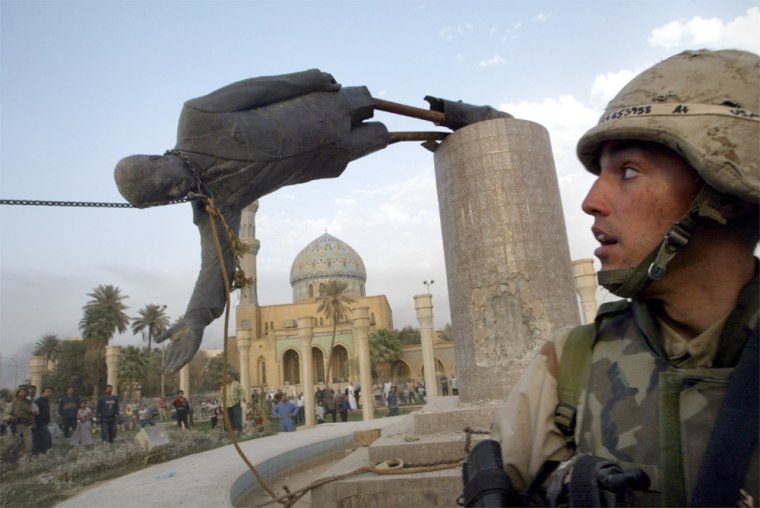With the capture of Saddam Hussein, Iraq’s fugitive dictator, Bush administration officials permitted themselves a moment of celebration but were being very cautious about making predictions about the impact of the achievement on the violent insurgency. Mindful of the overly rosy prognosis many issued after Saddam's sons, Uday and Qusai, were killed by the 101st Airborne Division in July, there appears to be a determination this time not to raise expectations too high.
“We obviously are thrilled at this, and yes, we consider him the ‘head’ of the beast and hope his capture demoralizes those resisting coalition troops,” a defense official told MSNBC.com early Sunday. “But we can’t say it’s over. There are others out there, and more to this fight than just Saddam.”
Still, Saddam’s capture, which followed eight months of mystery about his whereabouts, was bound to be viewed as a major accomplishment by both the political and military officials running the occupation.
“We got him,” proclaimed U.S. administrator L. Paul Bremer, the Bush administration’s top civilian official in Iraq. As he spoke, Iraqis who endured decades of repressive rule under Saddam and his Baath Party broke into celebration in Baghdad, Mosul and other major centers.
Banishing one specter
U.S. military and political authorities have been keenly aware of the abiding fear within Iraq, particularly among Saddam’s Sunni brethren, that Saddam might somehow ride out the occupation and return to power determined to wreak vengeance on anyone who collaborated with the U.S.-led coalition. That specter should now, barring a disaster, be vanquished.
However, military leaders insisted they were not viewing his capture as anything more than a step along a difficult road.
“Do I expect an increase in retaliation?” asked Lt. Gen. Ricardo Sanchez, the senior American military commander in Iraq. “I don’t know, but we’re prepared.”
Sanchez and other officials hope that even if Saddam’s capture doesn’t immediately take the steam out of the insurgency it will lead to a new windfall of intelligence on how the insurgents plan operations, receive orders and are compensated.
“We will continue to hunt them down just the way we’ve been consistently with Saddam Hussein,” says Sanchez. “We will not slack off until we have brought security and stability to the country.”
For several months now, American and British intelligence agencies have been warning that Saddam’s capture, while an important symbol of coalition power and determination, would not quickly diminish the pace or ferocity of the insurgency.
Indeed, just Sunday, with Saddam in captivity, an apparent suicide bomber detonated an explosives packed vehicle outside a Baghdad police station, killing at least 17 people.
The next target of the coalition manhunt -- an even more important target then Saddam in the minds of some intelligence officials -- is Izzat Ibrahim Al-Douri, who was vice president of Saddam’s “Revolutionary Command Council” and a wily old political and military henchman.
In recent months, U.S. military intelligence has come to believe that al-Douri may be the closest thing there is in the insurgency to a central coordinating force, though there are others who believe the insurgency to be far more organic and decentralized.
Focus on finance
One area of particular concentration recently has been the financial resources behind the insurgency.
Last month, the coalition began the painstaking process of distributing new Iraqi dinars bereft of Saddam’s image in the hope of nullifying the many millions of dinars thought to be in the hands of those fueling the insurgency.
But the extent of the regime’s control of Iraqi assets may make such efforts difficult, if only because enormous sums of hard currency are also thought to be in insurgent hands – used to pay bounties to those who mount operations against occupation troops.
“Most of what was looted was in the form of hard currency, mostly U.S. dollars,” says Rick Francona, a former U.S. intelligence agent who worked for years inside Iraq. “Assuming that Saddam was able to access holdings other than those which were intercepted, the insurgency could conceivably have tens of millions of dollars or more. There doesn’t seem to be any shortage.”
Accounts of raids provided by the U.S. military command increasingly have highlighted the amount of money captured, and indeed, some $750,000 in U.S. currency was discovered with Saddam and his entourage.
In the end, American forces took the fugitive dictator of Iraq alive, pulling him out of a hole in the ground after a tip from one of his former subjects. His bearded, soiled appearance was testament to the desperation of his situation, and American authorities made sure that photos and video of the disheveled despot were made available during Sunday’s news conference.
There appeared to be little doubt about the identity of the man in custody - certainly, none of the difficulties that surrounded the positive identification of Uday and Qusai, whose bodies were traumatized by the battle that killed them. Their father, in contrast, went "without a shot," as Sanchez emphasized. In the end, he found himself trapped in the same place he left his nation: in a deep, dark hole.
